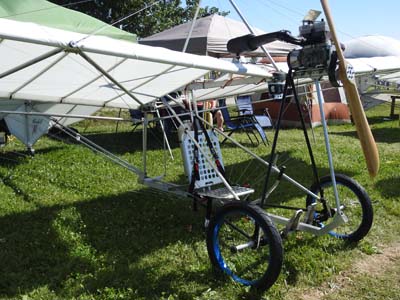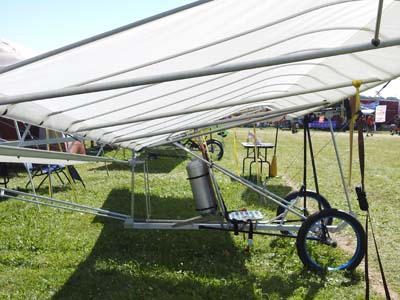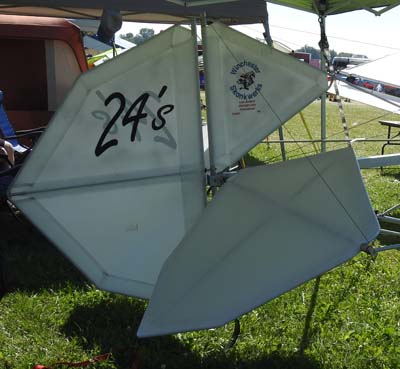 Update 8/17/17: See our video interview at EAA AirVenture Oshkosh 2017 on this aircraft (at bottom). —DJ
Update 8/17/17: See our video interview at EAA AirVenture Oshkosh 2017 on this aircraft (at bottom). —DJ
The aircraft you see in the photos is called “A Tribute to Alberto Santos Dumont.” Do you know who that is?
In my conversations with a few other pilots, almost everyone knew the name (“vaguely”) but not one remembered what that person did. Since the 24 Bis (that’s what they call the example you see in the images) is a tribute to Alberto, let’s take a second to recall his history.
Santos Dumont was a prolific aircraft designer working from 1898 to 1920. The first year was when he made his first balloon ascension, in Paris, on July 4th. Only six years later, not even three years after the Wright Brothers’ famous Kitty Hawk flight, Alberto flew his 14 Bis on November 12th, 1906. This flight won him the accolade “first person to fly in Europe.”

On January 4th, 1910, Santos Dumont broke a flying wire and crashed. He never flew again. History doesn’t record if his mishap was in a 19 Bis, or the 20, 21, or 22.
The Winchester Skonkwerks Ultralight Research and Development Facility — let’s shorten that to Skonkwerks — represents a team from Larsen, Wisconsin. Skonkwerks honored Alberto by first building a 23 Bis and later the 24 Bis you see in nearby images taken at AirVenture Oshkosh 2017. The group describes itself as a “loosely knit organization of friends, flyers, and fanatics… tinkerers, builders, and bullsh###rs. We are engineers, designers, and dreamers hanging out in a little hangar screwing stuff together and making it fly.”
The Plane that Never Was

Mark, Lee, and the whole merry band machined and welded the airframe and sewed Dacron wings, all the while learning both new skills and an appreciation for what Santos Dumont and his associates had done more than a hundred years earlier.
“You’re not going to fly it, are you,” Mark remembered his friends asking him? He did. Successfully. The aircraft you see was flown into Oshkosh. After flying airplanes from transport aircraft to ultralights and including a stint with FAA, Mark appears to be having the time of his life with this unusual winged contraption. He now serves on EAA’s Ultralight & Light-Sport Aircraft Council.

With this article you see no website or phone numbers. This aircraft is not for sale but is certainly worthy of you traipsing down to Oshkosh’s Fun Fly Zone (i.e., the Ultralight Area) to see for yourself.
Meanwhile, here’s a few facts you might enjoy:
- Weight — 240 pounds
- Wing Span — 32 feet
- Wing Area — 192 square feet
- Never Exceed Speed — 45-50 mph
- Stall Speed — 14-16
- Engine — Rotax 447
- Build Time — December 21, 2014 through June 21, 2015
Here’s our video interview with Lee Fisher at Oshkosh. He’s a funny fellow with a great project.
For lots more videos, please visit — and support! — Ultralight News…


Will a wingspan of 16 feet (chord 3.6 feet) of a homemade ultralight of empty weight 50kj (kg, or kilograms?) propelled by a 15-horsepower engine (RPM max 2500)?
Generate enough lift? –I also plan to use some lift augmentation devices.
Hello Stanley: I am not an engineer and would caution you against info someone might give you …but, a span of 16 feet seems too short even for a 50 kilogram (110 pound) ultralight, though I cannot imagine how you could build a man-carrying aircraft at that weight. ••• A 15 horsepower engine may well work on a very light aircraft; one of the first Quicksilvers I flew used that power and flew successfully on foam floats. It didn’t climb very quickly but was workable. Lift augmentation can be complex and I cannot guess how that impacts the plan.
Great 23! Santos-Dumont was a hero of mine since childhood. I wrote Popular Mechanics as a kid to purchase his Demoiselle plans not realizing in my youth plans from 1910 would not still be available in 1962. True story. A secretary from P.M. sent me a reply though. She graciously copied plans from the magazine in their archive for a few pennies taped to a piece of cardboard mailed to her. I still have those copies now having fingered and day dreamed over them for all this time. Glad to see someone or ones had the same dream and bore it to fruition. My compliments!
Hi Dan,
Here is a new report about the history and technical details of the
Demoiselle aircraft of Alberto Santos-Dumont:
http://www.westernexplorers.us/Demoiselle-original-history.pdf
Can you share this with Lee Fischer and Mark Solper? I have not found how to contact them directly, yet. I will mail Lee a paper copy of this report, if I find a mailing address.
Count me in as one of the Demoiselle gang. Questions about the Demoiselle are welcome.
Stuart Wier
Boulder
5400 feet
Hi Stuart; It’s been a minute or two. Here is some contact info. https://www.facebook.com/groups/758962676189079